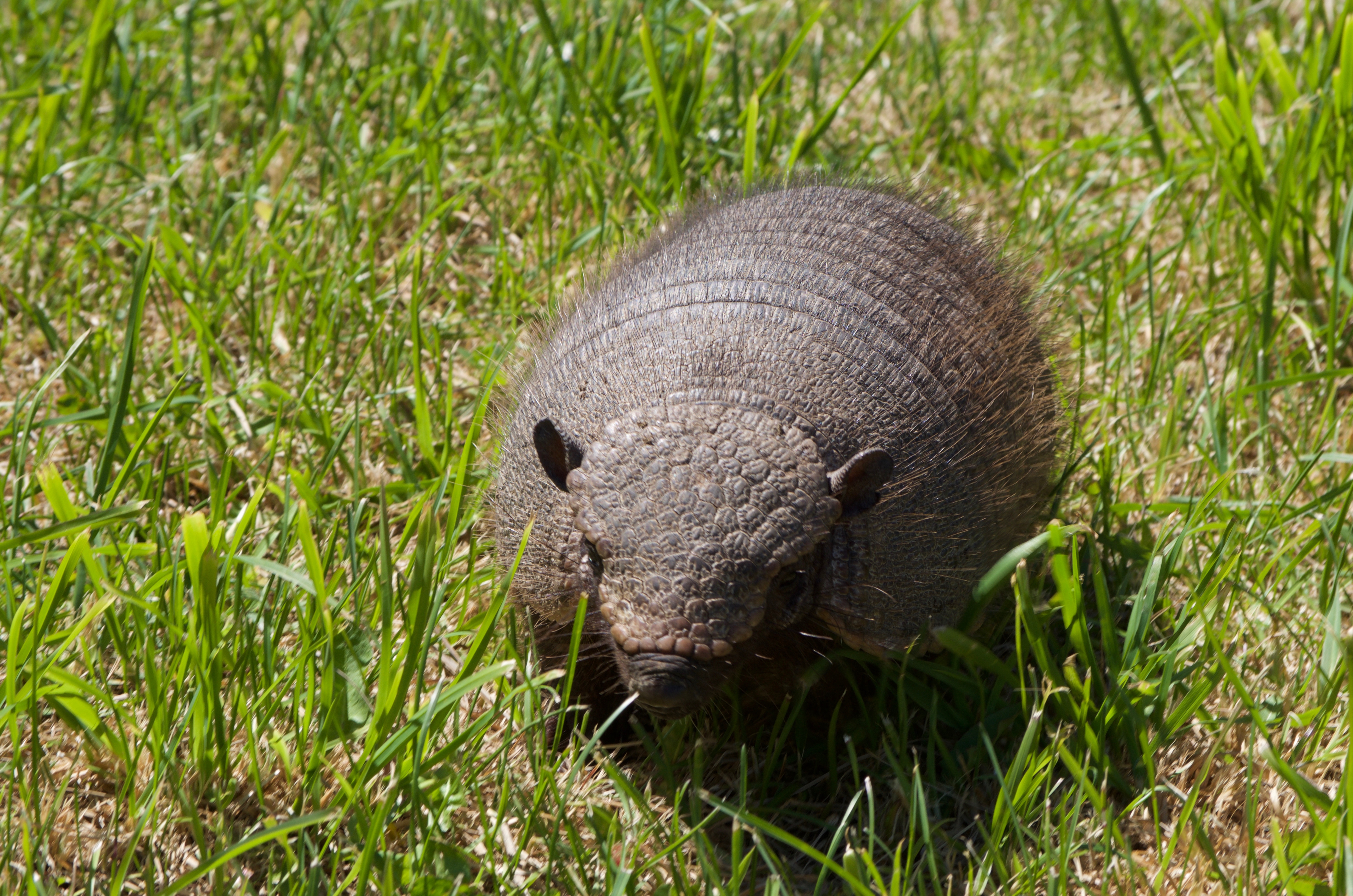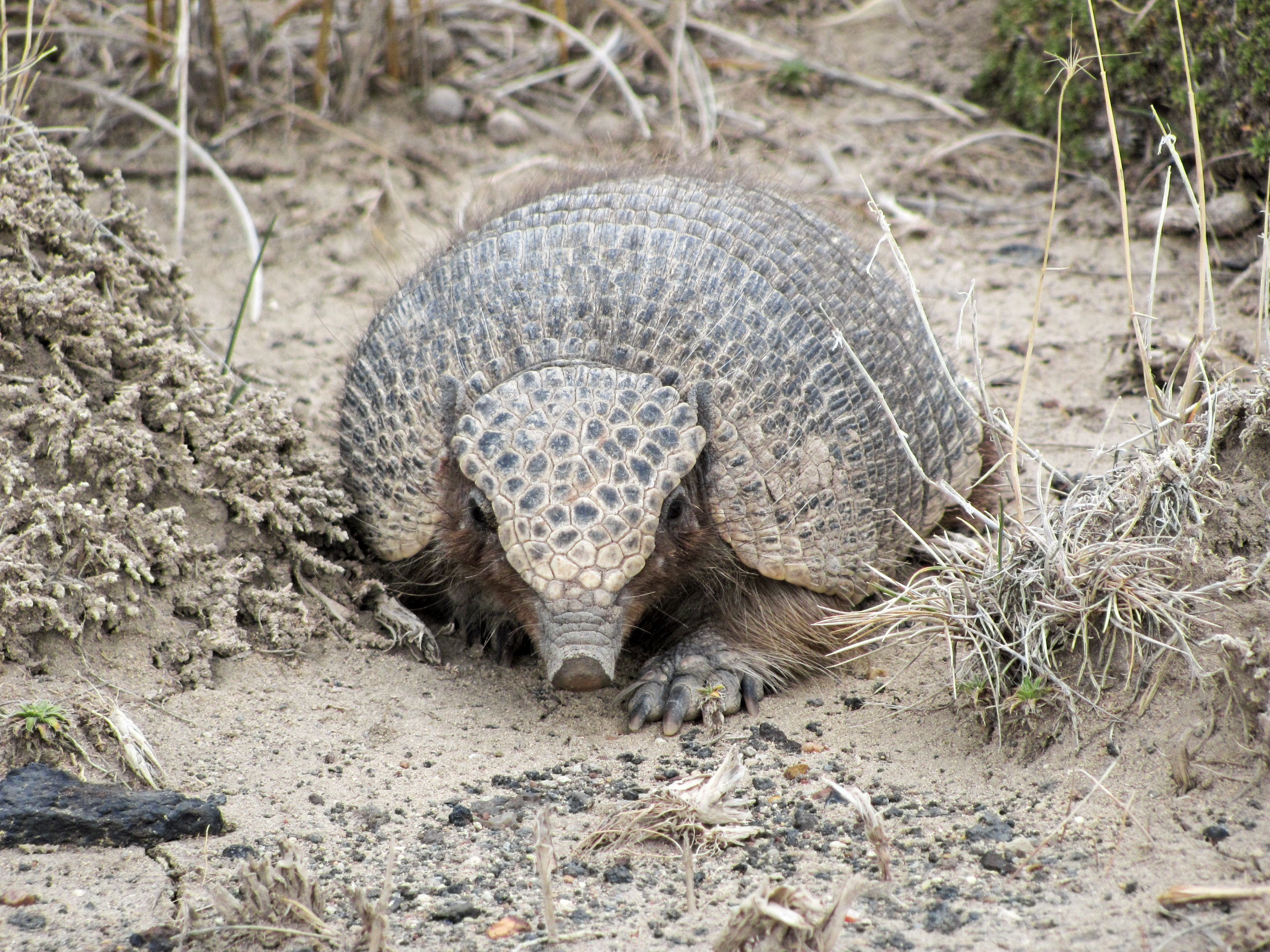Zaedyus on:
[Wikipedia]
[Google]
[Amazon]
The pichi (''Zaedyus pichiy''), dwarf armadillo or pygmy armadillo is an armadillo native to Argentina. It is the only living member of the genus ''Zaedyus'', and the only armadillo to hibernate.
 Pichis are relatively small armadillos, measuring approximately long, with a tail of about . Adults weigh anything from , and males may be slightly larger than females.
The carapace varies from light yellow to near-black, and consists of heavy scapular and pelvic shields composed of rectangular
Pichis are relatively small armadillos, measuring approximately long, with a tail of about . Adults weigh anything from , and males may be slightly larger than females.
The carapace varies from light yellow to near-black, and consists of heavy scapular and pelvic shields composed of rectangular 
 Pichis are solitary and diurnal. They dig burrows in sandy soil, which they use for shelter from extremes of weather. The burrows have a dome-shaped entrance and a single passage that can reach several metres in length, before terminating in a bare, unlined, resting chamber. They do not inhabit their burrows for extended periods, digging new ones at least every few weeks, and sometimes daily. During the winter, when the weather is more extreme, the burrows may be deeper than they are in the summer, reaching as much as below ground.
Pichis are solitary outside of the mating season. When threatened, they wedge themselves into their shallow burrow making it difficult for an attacker to drag them out because of their jagged scales, or else lie flat on the ground to protect their vulnerable belly. They have been reported to make both purring sounds and a loud grunt or scream.
Pichis are solitary and diurnal. They dig burrows in sandy soil, which they use for shelter from extremes of weather. The burrows have a dome-shaped entrance and a single passage that can reach several metres in length, before terminating in a bare, unlined, resting chamber. They do not inhabit their burrows for extended periods, digging new ones at least every few weeks, and sometimes daily. During the winter, when the weather is more extreme, the burrows may be deeper than they are in the summer, reaching as much as below ground.
Pichis are solitary outside of the mating season. When threatened, they wedge themselves into their shallow burrow making it difficult for an attacker to drag them out because of their jagged scales, or else lie flat on the ground to protect their vulnerable belly. They have been reported to make both purring sounds and a loud grunt or scream.
Description
 Pichis are relatively small armadillos, measuring approximately long, with a tail of about . Adults weigh anything from , and males may be slightly larger than females.
The carapace varies from light yellow to near-black, and consists of heavy scapular and pelvic shields composed of rectangular
Pichis are relatively small armadillos, measuring approximately long, with a tail of about . Adults weigh anything from , and males may be slightly larger than females.
The carapace varies from light yellow to near-black, and consists of heavy scapular and pelvic shields composed of rectangular osteoderm
Osteoderms are bony deposits forming scales, plates, or other structures based in the dermis. Osteoderms are found in many groups of extant and extinct reptiles and amphibians, including lizards, crocodilians, frogs, temnospondyls (extinc ...
s, and separated by six to eight movable bands. An additional "nuchal" band lies in front of the scapular shield, and there is also a triangular shield on top of the head, and further osteoderms along the tail. The underside of the animal has a coat of tan-coloured hair, which is thicker and longer in winter; there are also a few long hairs protruding through small holes near the posterior edge of some of the scales. Pichis have well-developed claws on all four feet. The ears are short, and the eyes dark and relatively small.
Pichis have eight teeth on each side of the upper jaw, and nine on the lower. The absence of teeth on the premaxilla
The premaxilla (or praemaxilla) is one of a pair of small cranial bones at the very tip of the upper jaw of many animals, usually, but not always, bearing teeth. In humans, they are fused with the maxilla. The "premaxilla" of therian mammal has ...
ry bone of the upper jaw is one of the features that allows them to be distinguished from other, similar, armadillos, such as the six-banded armadillo
The six-banded armadillo (''Euphractus sexcinctus''), also known as the yellow armadillo, is an armadillo found in South America. The sole extant member of its genus, it was first described by Swedish zoologist Carl Linnaeus in 1758. The six-b ...
. Females have two teat
A teat is the projection from the mammary glands of mammals from which milk flows or is ejected for the purpose of feeding young. In many mammals the teat projects from the udder. The number of teats varies by mammalian species and often corr ...
s, located in the chest region, and, like most armadillos, lack a true vagina
In mammals, the vagina is the elastic, muscular part of the female genital tract. In humans, it extends from the vestibule to the cervix. The outer vaginal opening is normally partly covered by a thin layer of mucosal tissue called the hymen ...
, instead having a single urogenital sinus
Sinus may refer to:
Anatomy
* Sinus (anatomy), a sac or cavity in any organ or tissue
** Paranasal sinuses, air cavities in the cranial bones, especially those near the nose, including:
*** Maxillary sinus, is the largest of the paranasal sinuses, ...
about in length. The male's penis is unusually long among mammals, being about 60% of the total body length.

Distribution and habitat
Pichis are found from central and southernArgentina
Argentina (), officially the Argentine Republic ( es, link=no, República Argentina), is a country in the southern half of South America. Argentina covers an area of , making it the second-largest country in South America after Brazil, th ...
(Patagonia
Patagonia () refers to a geographical region that encompasses the southern end of South America, governed by Argentina and Chile. The region comprises the southern section of the Andes Mountains with lakes, fjords, temperate rainforests, and g ...
), west to the Andean grasslands of Chile
Chile, officially the Republic of Chile, is a country in the western part of South America. It is the southernmost country in the world, and the closest to Antarctica, occupying a long and narrow strip of land between the Andes to the east a ...
, and south to the Strait of Magellan. Within this region, it most commonly inhabits arid or semiarid steppe grassland
A grassland is an area where the vegetation is dominated by grasses ( Poaceae). However, sedge ( Cyperaceae) and rush ( Juncaceae) can also be found along with variable proportions of legumes, like clover, and other herbs. Grasslands occur na ...
s, but may be found in other environments if they have sandy soils suitable for burrowing.
Subspecies
*''Zaedyus pichiy caurinus''Thomas
Thomas may refer to:
People
* List of people with given name Thomas
* Thomas (name)
* Thomas (surname)
* Saint Thomas (disambiguation)
* Thomas Aquinas (1225–1274) Italian Dominican friar, philosopher, and Doctor of the Church
* Thomas the A ...
, 1928
*''Zaedyus pichiy pichiy'' Desmarest, 1804
Biology
Pichis areomnivorous
An omnivore () is an animal that has the ability to eat and survive on both plant and animal matter. Obtaining energy and nutrients from plant and animal matter, omnivores digest carbohydrates, protein, fat, and fiber, and metabolize the nut ...
, with the largest part of their diet consisting of invertebrates such as beetle
Beetles are insects that form the order Coleoptera (), in the superorder Endopterygota. Their front pair of wings are hardened into wing-cases, elytra, distinguishing them from most other insects. The Coleoptera, with about 400,000 describ ...
s, ant
Ants are eusocial insects of the family Formicidae and, along with the related wasps and bees, belong to the order Hymenoptera. Ants evolved from vespoid wasp ancestors in the Cretaceous period. More than 13,800 of an estimated total of ...
s, and scorpion
Scorpions are predatory arachnids of the order Scorpiones. They have eight legs, and are easily recognized by a pair of grasping pincers and a narrow, segmented tail, often carried in a characteristic forward curve over the back and always en ...
s, though they will also eat small mammals or lizards, as well as plant material and fungi
A fungus ( : fungi or funguses) is any member of the group of eukaryotic organisms that includes microorganisms such as yeasts and molds, as well as the more familiar mushrooms. These organisms are classified as a kingdom, separately from ...
. Despite living in arid environments, they are not thought to drink water in the wild. Common predators include crowned eagles, buzzard-eagles, foxes, and cougars.
Pichis are the only armadillos known to hibernate. Like many hibernating animals, they build up considerable fat reserves before entering their winter burrows, where they remain from May to August. During hibernation, their body temperature drops from its normal value of about to just . In addition to true hibernation, they also enter a period of daily torpor
Torpor is a state of decreased physiological activity in an animal, usually marked by a reduced body temperature and metabolic rate. Torpor enables animals to survive periods of reduced food availability. The term "torpor" can refer to the time ...
, lasting up to four hours each night, during which their body temperature can drop to as low as .
The breeding season lasts from spring to early summer, with the exact months depending on latitude. Females may be induced ovulators, and give birth to one or two young after a gestation period of 58 to 60 days, typically between October and January. The young are born with soft, pink skin with tiny osteoderm
Osteoderms are bony deposits forming scales, plates, or other structures based in the dermis. Osteoderms are found in many groups of extant and extinct reptiles and amphibians, including lizards, crocodilians, frogs, temnospondyls (extinc ...
s that begin to harden and turn more yellow after about two weeks. Newborn pichis weigh about , and put on an average of per day until weaning ends at about 40 days and they leave the burrow for the first time.
Behaviour
Conservation status
The IUCN has rated the conservation status of ''Z. pichiy'' asnear-threatened
A near-threatened species is a species which has been categorized as "Near Threatened" (NT) by the International Union for Conservation of Nature as that may be vulnerable to endangerment in the near future, but it does not currently qualify f ...
. It is hunted for subsistence and sport, despite being protected in both Argentina. The armadillo is eaten and used in local handicrafts. Cattle ranching poses a threat to its habitat. Some populations have also been impacted by an unknown disease.
References
External links
{{Taxonbar, from=Q244174 Armadillos Mammals of Patagonia Mammals of Argentina Mammals of Chile